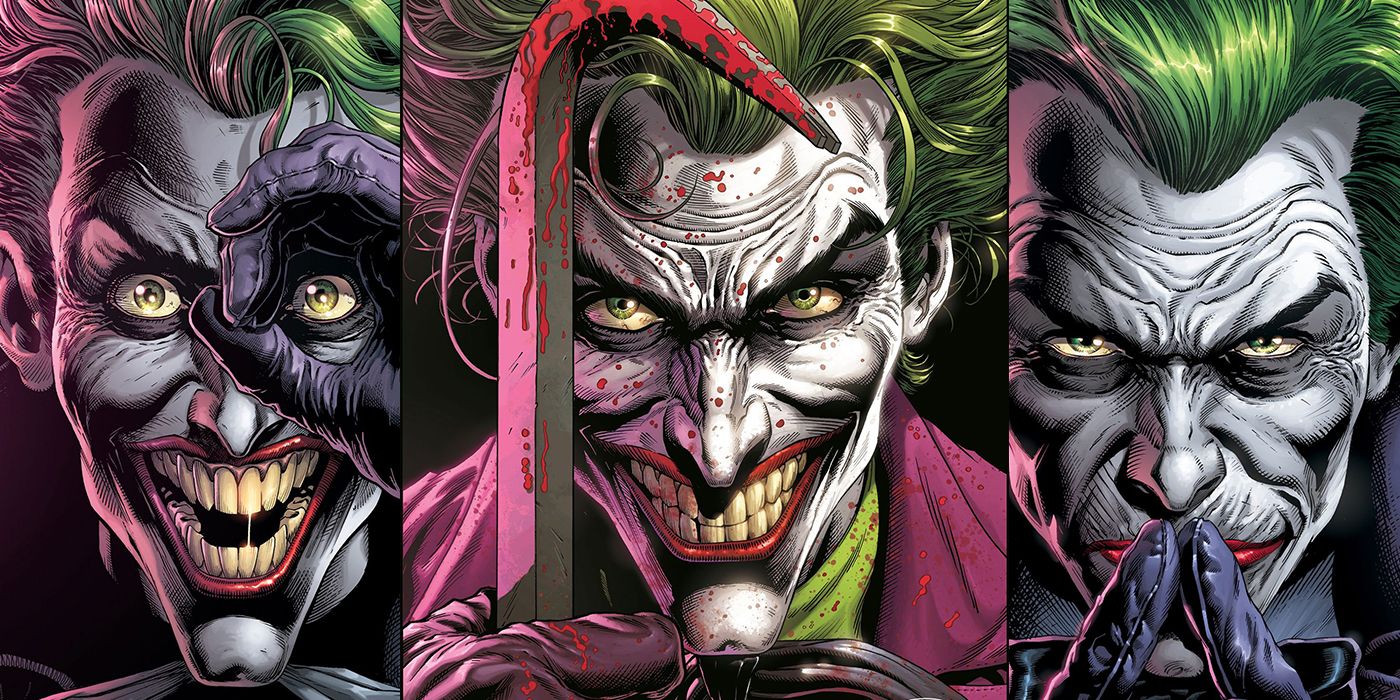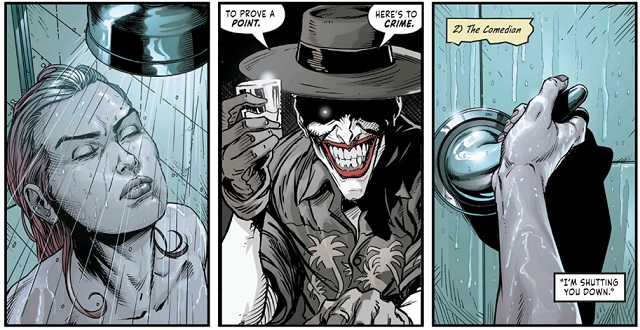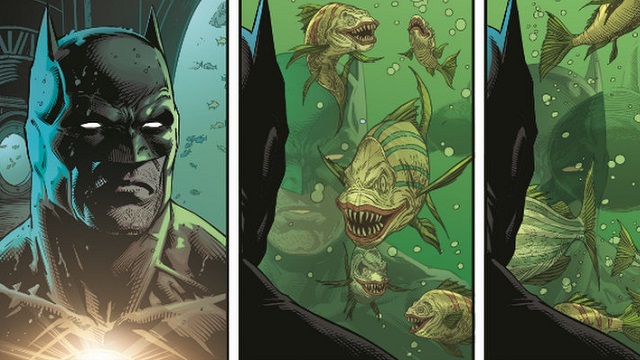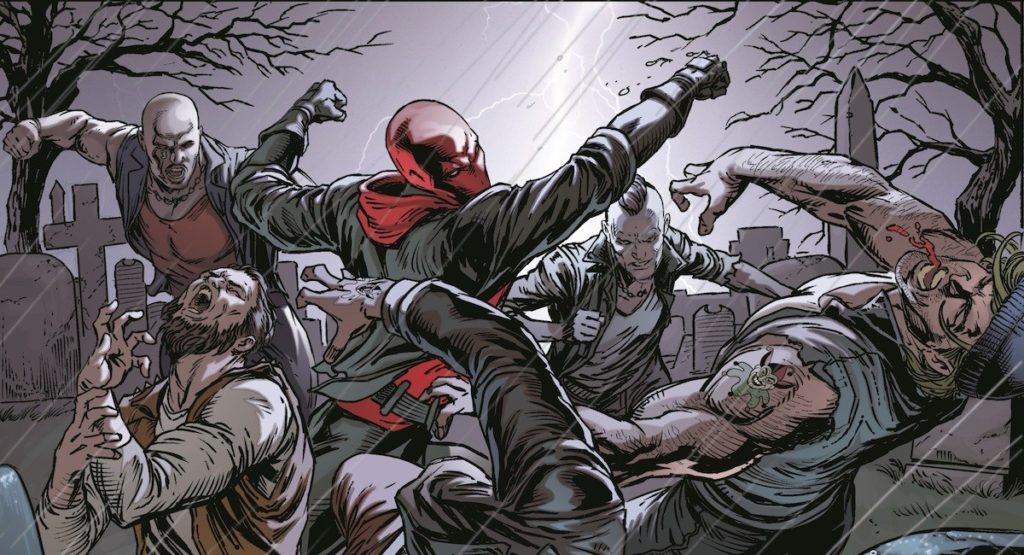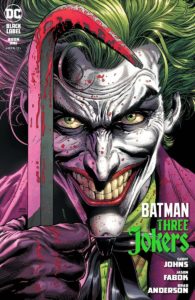

Taking a bit of a breather between introducing the concept, and completing the meta-narrative Doomsday Clock, writer Geoff Johns’ first issue of Three Jokers has finally hit shelves.
As he had done with Doomsday Clock, Johns is balancing a few different narrative threads while simultaneously offering a meta-textual exploration of Gotham’s Clown Prince Of Crime. In doing so, he parses through several of the Joker’s most memorable — and influential — personas, and how he has affected most three central members of the Batman Family: Batman, Barbara Gordon, and Jason Todd.
The story opens by focusing on the scars left by the Joker on the three members of the Batman Family most impacted by his presence. First, a literal web of scars on Batman’s body, as Alfred stitches him up, and a focus on when and how each scar was made: a stabbing by the Penguin; a bite from Killer Croc; a branding by the Riddler…and a plethora of lethal tricks, one after the other, from the Joker. Next, we cut to Barbara Gordon, jogging on a treadmill, flashing back to the Joker’s paralyzing assault of her, and later, washing up, the scar from the bullet hole that paralyzed her.
And finally, we encounter the Red Hood, beating up several Joker hoods in a graveyard, casually maximizing the pain inflicted, as at one point his helmet slides off, and we see an impact scar at the back of his head, and a flashback to Joker swinging a crowbar at him. Weaving between these three different settings are news reports of the Joker striking separate parts of Gotham…seemingly simultaneously.
Faced with the prospect of another convoluted Joker plot, the trio of heroes attempt to logically parse out whatever the Joker’s got planned: there’s no possible way there’s more than one of him, there have to be copycats. And yet, Batman remembers his experience in the Moebius Chair, and its tantalizingly confusing declaration: “There are three.” And three there are, as, in a scene set in secluded cabin, three manifestations of the Harlequin of Hate rendezvous: the Criminal, the Clown, and the Comedian, each personified in differences in clothing, and slight variations of demeanor.
- The Criminal Joker — ostensibly the “leader”, inasmuch as the Joker can be led by anyone — is quiet, cold, patient, and a spitting image of the character’s first appearance in Batman #1 from 1940.
- The Comedian Joker seems the most unpredictable, yet almost whimsical, and the most unstable…constantly jabbing barbs into his other counterparts, and is responsible for recreating his Joker Fish scheme at the Gotham Aquarium (as well as bringing back diminutive henchman Gaggsy), this time updating it by infecting a Great White Shark with his nearly-patented smile.
- The Clown Joker seems to straddle between the two: cold, but not without his dark sense of humor, and calculating, but still prone to unpredictability.
Breaking the villain into these three distinct personalities seems a natural evolution from Grant Morrison’s morbid, cynical, yet fascinating, take on the character from Arkham Asylum: A Serious House On Serious Earth: the Joker, as a person, has no real personality, but merely reflects and reacts to whatever is stimulating him on the day, in a sort of “super-sanity”, a sensory overload to which he merely reacts accordingly…or overwhelmingly.
That would go a long way to explaining why in some stories he’s a criminal mastermind; in others, a whimsical fool, almost silly and playful (“Joker’s Utility Belt”, anyone?); and now we have the latest incarnation: a homicidal genius who is quick to make fun, but quicker to slice throats at random. Somewhere between Morrison’s concept of the Joker’s “super-sanity”, and the idea of the character constantly reinventing himself in a bizarre rebirth of sorts, Three Jokers sits nicely.
The art by Jason Fabok is fantastic, as is most of his works. He is capable of subtly discerning between the three individual Jokers, complimenting Johns’ almost supernatural understanding of this universe and its characters. Tying the entire history of this villain — which also requires exploring some of the meta-textual themes of the evolution of Batman, himself, as a character, along with his main villain, and the evolution of comic-book violence and nihilism as well — seems as risky a venture as writing a sequel to Watchmen that incorporates that universe to the larger DC Universe…while also simultaneously deconstructing the meta-narrative history of comics as a medium. Will we get to those same highs? Probably not, and the result will probably be just as uneven (as great as Johns is at building up narrative and meta-textual ideas, he doesn’t quite always get the landing).
This is an interesting opening issue (with an ending I wasn’t quite expecting…but which is very satisfying regardless), and if it can be read as a more meta-textual deconstruction of the Joker, rather than a linear, exact, “serious” story, then I’ll probably appreciate it much more. More pieces like the aforementioned Arkham Asylum seem the perfect style in which to explore a character as manic as the Joker. Here’s hoping the remaining two issues in this series remain as compelling, otherwise the joke will be on us. 3.75/5 Joker Sharks.
-J.L. Caraballo

